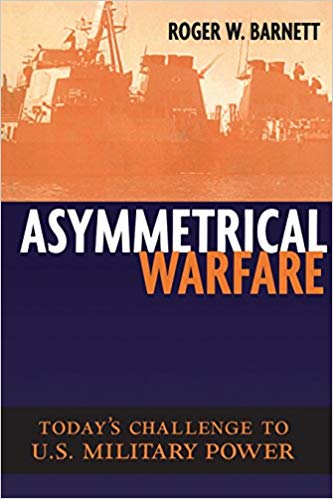Asymmetrical Warfare by Roger W. Barnett
This book is a detailed look at the modern challenges to US military power written by a retired US Naval Captain with extensive experience in military strategy and planning. It is one volume in a series titled ‘Issues in twenty-first century warfare’. This study is written methodically and unemotively, exploring the ‘so what’ and ‘therefore’ in a manner that makes it easy to consume for those military minded readers.
To set the tone, Barnett argues that ‘True asymmetries… are those actions that an adversary can exercise that you either cannot or will not’. The understanding of this definition is the foundation of the book and readers are warned against the follies of believing that asymmetrical warfare is simply ‘emphasizing one’s strengths and exploiting an enemies weaknesses’ which is merely the basis of strategy.
This book examines the limitations that come with being a global hegemony and a democratic nation when coming up against adversaries who do not have similar constraints or are not part of the same treaties and organisations that govern global conduct. Barnett uses historical case studies throughout, combined with a considerable amount of research to put together a well considered and academic demonstration of the constraints to US military power and its use. The crux of the study delves into the operational, organisational, legal and moral constraints posed to the US (and by extension, most western nations) and in true military fashion, breaks these down further to identify key sources within each.
At the conclusion of outlining the constraints, Barnett looks at the effects of these and possible ‘remedies’. It is in identifying solutions that this book, like many of its contemporaries, falls short. Although the ‘remedies’ laid out by Barnett are a well thought out progression of what he had written throughout the book, they read more like a wish list than a viable strategy noting that the same limitations he wrote about throughout the book, such as moral constraints, would apply to his resolutions as well, such as the use of mercenaries.
It is hard to criticise a book for not coming up with a concrete solution to such a complex issue as asymmetrical warfare however. Barnett does cite factors such as leadership as having a part to play in overcoming the issue, in addition to examining the desired end state of conflict prior to entering it as well as considering the ways and means to ensure these are measured and balanced to the end state. This is a common ‘fix’ among similar books that look at the ‘what went wrong’ aspect of warfare.
The main method spoken of within the novel that seems to work in most cases is deterrence, be it deterrence by the threat of retaliation (such as nuclear warfare, where the threat of mutually assured destruction would need to be considered as an acceptable risk to the opposing force) or through deterrence by denial (such as constraints on trade or economic agreements). There are of course times when deterrence is not viable, ‘deterrence is undermined daily, and the battlespace becomes ever more skewed’.
As a junior Officer with limited knowledge in this field I found this book to be a good foundational look at what asymmetrical warfare is and how it constrains western and more accurately, democratic society. There was nothing written in this book that I would not naturally conclude when considering the constraints posed, however this book brought to bear the more academic study of the topic and noting that it is not a subject that I had thought of deeply before, allowed me the time and space to do so.
One of the most interesting facets to this study in my opinion was the examination of moral constraints to the use of force. This is arguably what defines asymmetrical warfare, especially in the definition provided by the author. The separation of the examination between moral and legal constraints within the book was also notably interesting and left this reader thirsty for further study on the topic.
I believe that most military commanders would find this book interesting and informative dependant on the prior level of knowledge on the topic. This book, as complete in its presentation as it may be, has left me curious about the other studies within the series.
As an aside, the bibliography for this book will give you a whole new list of interesting reading material to get lost in. Enjoy!
Jess Ward is a currently serving Australian Army Officer with over a decade of experience. Jess has commanded within Combat Brigades, on Operations and as an instructor. Jess has been published in ‘Winning Westeros: How Game Of Thrones explains modern military conflict’ as well as several professional military education websites. Jess curates The Bookshelf. Follow Jess at @JessPixWard.

